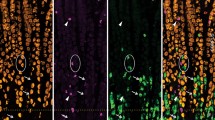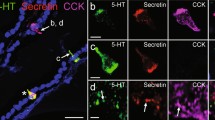Summary
Secretin has been localized by the immunogold technique in endocrine cells of the dog duodenum — previously described as “K cells” — characterized by secretory granules with double structure consisting of a secretin-containing osmiophilic core surrounded by an argyrophil halo. Granules resembling those of dog secretin cells were also found in some ultrastructurally characterized S cells of the cat, pig, rat and rabbit duodenum, thus confirming in these species the identification of S cells with secretin cells. Conversely, the cells previously described as “S cells” in the dog lacked secretin immunoreactivity.
Similar content being viewed by others
References
Alumets J, Hakanson R, O'Dorisio T, Sjölund K, Sundler F (1978) Is GIP a glucaon cell constituent? Histochemistry 58:253–256
Baetens D, Rufener C, Srikant C, Dobbs R, Unger R, Orci L (1976) Identification of glucagon-producing cells (A cells) in dog gastric mucosa. J Cell Biol 69:455–464
Bendayan M, Zollinger M (1983) Ultrastructural localization of antigenic sites on osmium-fixed tissues applying the protein A-gold technique. J Histochem Cytochem 31:101–109
Bodanszky A, Ondetti MA, Mutt V, Bodanszky M (1969) Synthesis of secretin. IV. Secondary structure in a miniature-protein. J Am Chem Soc 91:944–949
Buchan AMJ, Polak JM, Solcia E, Capella C, Pearse AGE (1978) Electronimmunocytochemical evidence for the K cell localization of gastric inhibitory polypeptide (GIP) in man. Histochemistry 56:37–44
Buffa R, Polak JM, Pearse AGE, Solcia E, Grimelius L, Capella C (1975) Identification of the intestinal cell storing gastric inhibitory peptide. Histochemistry 43:249–255
Bussolati G, Capella C, Solcia E, Vassallo G, Vezzadini P (1971) Ultrastructural and immunofluorescent investigations of the secretin cell in the dog intestinal mucosa. Histochemie 26:218–227
Capella C, Solcia E (1972) The endocrine cells of the pig gastrointestinal mucosa and pancreas. Arch Histol Jpn 35:1–29
Capella C, Solcia E, Vassallo G (1969) Identification of six types of endocrine cells in the gastrointestinal mucosa of the rabbit. Arch Histol Jpn 30:479–495
Capella C, Solcia E, Vassallo G (1972) Ultrastructural and histochemical investigations on the endocrine cells of the intestinal mucosa. In: Taylor S (ed) Endocrinology 1971. Heinemann, London, pp 282–290
Grimelius L (1968) A silver nitrate stain for α2 cells in human pancreatic islets. Acta Soc Med Upsal 73:243–270
Larsson L-I, Moody AJ (1980) Glicentin and gastric inhibitory polypeptide immunoreactivity in endocrine cells of the gut and pancreas. J Histochem Cytochem 28:925–933
Larsson L-I, Sundler F, Alumets J, Håkanson R, Schaffalitzky de Muckadell OB, Fahrenkrug J (1977) Distribution, ontogeny and ultrastructure of the mammalian secretin cell. Cell Tissue Res 181:361–368
Mutt V, Jorpes JE, Magnusson S (1970) Structure of procine secretin: the amino acid sequence. Eur J Biochem 15:513–519
Polak JM, Bloom SR (1980) Neural and cellular origin of gastrointestinal hormonal peptides in health and disease. In: Glass GBJ (ed) Gastrointestinal hormones. Raven Press, New York, pp 19–51
Polak JM, Bloom S, Coulling I, Pearse AGE (1971) Immunofluorescent localization of secretin in the canine duodenum. Gut 12:605–610
Roth J, Bendayan M, Orci L (1978) Ultrastructural localization of intracellular antigens by the use of protein A-gold complex. J Histochem Cytochem 26:1074–1081
Sevier AC, Munger BL (1965) A silver method for paraffin sections of neural tissue. J Neuropathol Exp Neurol 24:130–135
Singh I (1964) A modification of the Masson-Hamperl method for staining of argentaffin cells. Anat Anz 115:81–82
Smith PH, Merchant FW, Johnson DG, Fujimoto WY, Williams RH (1977) Immunocytochemical localization of gastric inhibitory polypeptide-like material within A-cell of the endocrine pancreas. Am J Anat 149:585–590
Solcia E, Vassallo G, Capella C (1970) Cytology and cytochemistry of hormone producing cells of the upper gastrointestinal tract. In: Creutzfeldt W (ed) Origin, chemistry, physiology and pathophysiology of the gastrointestinal hormones. Schattauer, Stuttgart, pp 3–29
Solcia E, Capella C, Chieli T, Bellini O, Bertazzoli C (1972a) Effect of chronic caerulein overdosage on the pancreas and gastrointestinal tract. In: Demling L (ed) Gastrointestinal hormones. G Thieme, Stuttgart, pp 103–113
Solcia E, Capella C, Vezzadini G, Barbara L, Bussolati G (1972b) Immunohistochemical and ultrastructural detection of the secretin cell in the pig intestinal mucosa. Experientia 28:549–550
Solcia E, Capella C, Vassallo G, Buffa R (1975) Endocrine cells of the gastric mucosa. Int Rev Cytol 42:223–286
Solcia E, Capella C, Buffa R, Frigerio B (1976) Histochemical and ultrastructural studies on the argentaffin and argyrophil cells of the gut. In: Coupland RE, Fujita T (eds) Chromaffin, enterochromaffin and related cells. Elsevier, Amsterdam, pp 209–225
Solcia E, Buffa R, Capella C, Fiocca R, Yanaihara N, Go VLW (1980) Immunohistochemical and ultrastructural characterization of gut cells producing GIP, GLI, glucagon, secretin and PP-like peptides. In: Creutzfeldt W (ed) Front. Hormone research, vol 7. Karger, Basel, pp 7–12
Stefanini M, De Martino C, Zamboni L (1967) Fixation of ejaculated spermatozoa for electron microscopy. Nature 216:173–174
Usellini L, Capella C, Solcia E, Buchan AMJ, Brown JC (1984) Ultrastructural localization of gastric inhibitory polypeptide (GIP) in a well characterized endocrine cell of canine duodenal mucosa. Histochemistry 80:85–89
Vassallo G, Solcia E, Capella C (1969) Light and electron microscopic identification of several types of endocrine cells in the gastrointestinal mucosa of the cat. Z Zellforsch 98:333–356
Vassalo G, Capella C, Solcia E (1971) Grimelius' silver stain for endocrine cell granules, as shown by electron microscopy. Stain Technol 46:7–14
Author information
Authors and Affiliations
Rights and permissions
About this article
Cite this article
Usellini, L., Capella, C., Frigerio, B. et al. Ultrastructural localization of secretin in endocrine cells of the dog duodenum by the immunogold technique. Histochemistry 80, 435–441 (1984). https://doi.org/10.1007/BF00495431
Accepted:
Issue Date:
DOI: https://doi.org/10.1007/BF00495431




